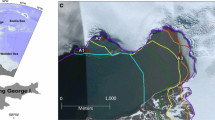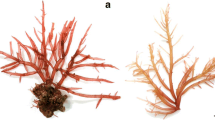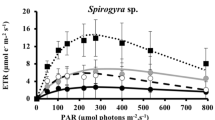Abstract.
Marine macroalgae inhabiting Arctic coastal ecosystems are exposed to pronounced seasonal variations in the radiation regime, including harmful UVB radiation. This study presents the first data on the seasonal changes in the sensitivity of macroalgal photosynthesis towards UV exposure by comparing under-ice, clear-water and turbid-water conditions characteristic for late winter, spring and summer. Various brown (Laminaria saccharina, L. digitata, L. solidungula, Saccorhiza dermatodea, Desmarestia aculeata), red (Palmaria palmata, Devaleraea ramentacea) and one green macroalgal species (Monostroma aff. arcticum) were collected at the same water depth throughout the seasons in the Kongsfjord (Spitsbergen, Svalbard, Norway). Maximum quantum yield (F v/F m) and maximum photosynthetic electron transport rates (ETRmax) were determined immediately after collection, after 2 h exposure to artificial UV radiation and after 18 h recovery in dim white light. Photosynthesis of the studied species showed different responses depending on their morpho-functional and physiological characteristics, their life strategies, phenology and depth distribution. Within the genus Laminaria, maximum quantum yield of adult specimens of the deep-water species L. solidungula was most strongly UV sensitive. Adult L. saccharina exhibited a lower UV sensitivity than a 6-month-old specimen. Inhibition of photosynthesis after UV exposure remained at the same level throughout the study period, both in adult L. saccharina and S. dermatodea. However, adult specimens of L. saccharina collected in May showed partial recovery only, whereas photosynthesis of specimens from both species collected later recovered fully. D. aculeata exhibited a remarkable decrease of UV sensitivity during the study period. Photosynthesis of specimens collected under the ice was strongly inhibited by UV, but the degree of inhibition decreased during spring and summer. Concomitantly ETRmax values were low after UV exposure in specimens collected in June, but increased later in the season. P. palmata exhibited a relatively flexible response. Photosynthesis in specimens collected under the ice in June or in turbid water in July/August was relatively strongly inhibited; specimens collected during sunny periods and in clear water in spring showed a much lower degree of photoinhibition after UV exposure. The seasonal pattern of low/high ETRmax values in spring/summer is probably a characteristic of the life strategy of this species. The UV sensitivity of D. ramentacea exhibited a similar seasonal pattern. In M. aff. arcticum, UV sensitivity increased and ETRmax values decreased during the study period, reflecting the life strategy of this annual late winter/spring species. The physiological basis for the seasonal changes in UV sensitivity of photosynthesis is presented in a companion paper (this issue).
Similar content being viewed by others
Author information
Authors and Affiliations
Additional information
Electronic Publication
Rights and permissions
About this article
Cite this article
Bischof, .K., Hanelt, .D., Aguilera, .J. et al. Seasonal variation in ecophysiological patterns in macroalgae from an Arctic fjord. I. Sensitivity of photosynthesis to ultraviolet radiation. Marine Biology 140, 1097–1106 (2002). https://doi.org/10.1007/s00227-002-0795-8
Received:
Accepted:
Issue Date:
DOI: https://doi.org/10.1007/s00227-002-0795-8




